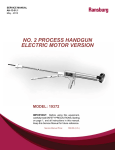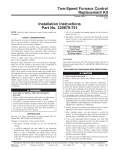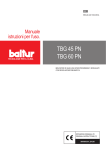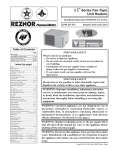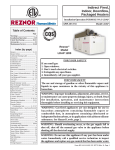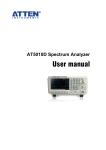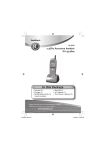Download Simplicity 960 Service manual
Transcript
Operators Handbook and Service Manual TEKK KS-960 (KS-900N) Crystal Controlled Digital Data Radio This Manual is intended for use by both the Operator and the Service Technician and is therefore divided into two logical parts. The operation chapter presents all the necessary information to connect, adjust and place the radio in operation. The service chapter provides all the necessary information and data to test, align, and repair the radio. This document was included with the order of the KS-960. There is no copyright or any other notice restricting distribution of this information. It is being presented here for archival purposes. Please use this information responsibly. Introduction The KS-960 Series is available in a Low and High Band configuration. The suffix L and H indicate Low and High respectively. The Low Band radio is intended for operation between 430 and 450 MHz. The High Band version for operation between 450 and 470 MHz. Because there are a number of component differences between the Low and High Band Radios it is not generally feasible to use a Low Band Radio on a High Band Frequency. The opposite case also being true. There is enough mounting space in the radio case for the inclusion of a miniaturized modem or other special purpose devices. For the purpose of simplicity throughout the rest of this manual, the Radio will be called the KS-960 regardless of the band of operation. Performance Specification GENERAL FCC Acceptance ID # Operating Voltage Operating Temperature Range Dimensions in Inches Approximate Weight Antenna Impedance User Interface Case RECEIVER GOXKS-900 Accepted for FCC Part(s) 15, 22, and 90 Frequency Range High Band 7.5 - 12Volt DC, Recommended Operating Voltage is 9.6Volt DC. -30 to +60 deg Celsius 3 5/8 x 2 ¼ x 1 ¼ 199 Grams (7 Oz) 50 Ohm BNC Antenna Interface 9 Pin D Type (DB-9) Spot Welded Steel with removable Top and Bottom. Sensitivity Selectivity Spurious Rejection Frequency Stability Audio Response Audio Distortion Audio Output Receiver Recovery Time to Stable D Current Drain, Squelched <0.35 uV for 12 dB SINAD 70dB 60dB +/- 5ppm Flat < 5% 750 mV RMS < 8 mS 20 mA Transmitter Power Output Duty Cycle Spurious Radiation Harmonic Radiation Modulation Attack Time to Stable Data Audio Response Distortion Data Modulation Level for 3.5KHz Deviation Approximate Current Drain at 2 Watts 2 Watts at 9.6 Volts 2 min. On, 1 Min Off > 60 dB below carrier > 60 dB below carrier Varactor Controlled Direct FM < 8 mS Flat < 5% 50 mV RMS 900 mA Data Interface Connector PIN 1 2 3 4 5 6 7 8 9 Chapter 1 - Operation FUNCTION (+) Supply Voltage (-) Supply Voltage PTT Line, ground to transmit Transmit Data In Receive Data Out No Connection Data Ground Analog Received Signal Strength Indicator, (RSSI) Carrier Detect Level Voltage, CD The KS-960 is a Half-Duplex UHF Transceiver with crystals controlling the Transmit and Receives Frequencies. Half-Duplex indicates that the radio can transmit on a frequency that is different from the receive frequency but can not RECEIVE and TRANSMIT at the same time. For the single channel KS-960 there is no limit to the separation of the Transmit and Receive frequencies as long as both are in the same, high or low band. There is no limit to the separation of the receive and transmit frequencies. The frequency controlling crystals are soldered directly to the board so that frequency or crystal changing in the field is not generally recommended. Further, if the NEW frequency is more than 3 to 4 megahertz different from the OLD frequency, the radio should be realigned to insure maximum performance. Very careful attention has been given to the design of both the transmitting and receiving oscillators to insure an extremely high degree of frequency stability, however, please bare in mind that no oscillator can be better than the crystal used. Low Cost and Bargain crystals can not and will not provide the frequency stability your system will require. To place the KS-960 in operation it is only necessary to connect the Receiver Data Out, (Pin 5), transmit Data In (pin 4), and the PTT (pin 3) to the Modem ad to provide a source of stabilized supply voltage between 7.5 and 12 Volts DC. The PLUS line is connected to Pin 1 with the ground or minus line connected to Pin 2. Any suitable 50 Ohm Antenna adjusted or cut to the operating frequency may be used. (More information on suitable antenna is given in the Service Chapter.) The use of a good quality, regulated power supply capable of delivering at least one Amp of current is strongly recommended. Many Bargain power supplies are effected by transmitter energy and can not be relied on to deliver the proper voltage when the transmitter is keyed. CONNECTIONS AND ADJUSTMENTS Pin 5, RECEIVED DATA OUT Most modems will have a means of controlling the input level of the received data signal. There is no internal means of adjusting this level in the KS-960. The KS-960 will deliver a DC coupled signal with a level of approximately 750mV RMS. The level control in the modem should be adjusted to accept this signal. Please remember that the Received Data Signal out of the KS-960 is direct coupled and will have a DC component. Pin 4, Transmit Data IN In many Modems, the Data Out Signal used to Modulate the KS-960 is a fixed level. To allow for proper modulation of the KS-960 a level or deviation control, VR1, has been included. If the Modem used also has a level control It should be set so that the level of the output signal is approximately 50 mV. The final adjustment for proper deviation should be made with VR1 using suitable test equipment as described in the Service Chapter Step 8. Pin 7, Signal Ground It is strongly recommended that the Pin 7 be used for the ground return for both Pin 4, Transmit Data and Pin 3, Received Data to reduce the possibility of ground return problems. Pin 3, Send-Receive Switch (PTT) Most Modems provide a connection (Closer) to Ground to key the transmitter ON. The KS-960 PTT line may be stitched to ground via a switch, relay, or an NPN Transistor. There will be approximately +6 Volts DC on the PTT line in the open, key up, state. It is strongly recommended that Pin 2, the minus supply voltage line be used as the ground return for the PTT line. Pin 9, Carrier Detect (CD) The Carrier Detect (CD) line is an NPN transistor switch which closes to ground when a carrier is present in the receiver bandpass. With NO SIGNAL the Pin 9 voltage will be approximately +6 Volts DC. When a signal is present the voltage will drop to almost zero. Its function is similar to what is more commonly known as squelch except that it has no effect on the Received Data output line. Pin 9 can sink up to 30mA of current. The sensitivity or switch point of the CD circuit can be set with VR2 located on the main circuit board. If the Modem is designed to use a Carrier Detect Signal it may be connected to Pin 9. Generally the Modem uses the CD signal to prevent the generation of a transmit command (PTT) until the receiver squelch has closed indicating that the received signal carrier has dropped and that the channel is clear. If the Modem does not have its own Data Carrier Detect (DCD) logic, it is strongly recommended that the Carrier Detect be used. The Received Data Signal does not pass through and is not effected by the CD switch circuit or the setting of the CD level control VR2. Pin 8, Received Signal Strength Indicator (RSSI) A Microampmeter may be connected directly to Pin 8 to indicate the relative strength of the received signal. The circuit has a dynamic range of about 60 dB with a scale factor of approximately 0.8uA per dB. A meter with a 50 uA movement will provide a suitable indication of the signal strength. The Meter may be left connected at all times. Once installed and placed in operation, a correctly adjusted and aligned KS-960 should provide years of trouble free operation. CHAPTER 2 - SERVICE Receiver, General The receiver is a double conversion superheterodyne with both injection oscillators being controlled by high quality crystals. The first injection signal is generated in a two transistor chain that multiplies the frequency of the third overtone crystal nine times. The oscillator is temperature stabilized to insure maximum performance over a wide range of temperatures. The first IF Frequency is 21.4 MHz with the second IF located at 455KHz. The receiver bandpass is carefully controlled by the use of two specially selected and matched two pole monolithic ceramic filters in the first IF and a four pole ceramic filter in the second IF. The heart of the receiver is a newly designed surface mounted Motorola chip that contains all of the circuitry necessary to produce the detected AF signal, RSSI and CD. The chip also has an internal oscillator and mixer to convert the 21.4 MHz IF to 455KHz, as well as a very high gain IF amplifier and limiter. THEORY OF OPERATION The Signal arriving at the antenna are coupled over two halfwave lowpass filter sections, L14 and L13 via C1 to the input dual helix transformer T1 and to the base of the RF amplifier Q1. Q1 provides approximately 20 dB of gain. A second dual helix filter couples the signal from the collector of Q1 to the base of the mixer Q2. The base of both Q1 and Q2 are protected from dangerously strong signals by the diodes D1 and D2 respectively. The injection signal out of the first Local Oscillator chain is coupled via C5 to the emitter of Q2. T3, the collector load for the mixer transistor, is tuned to 21.4MHz. Further filtering and bandpass shaping is provided by the ceramic filters F1 and F2. Q5 is a wide band amplifier which provides enough gain to offset the filter loss but is used primarily to match the filter impedance to the input of the IC1 receiver chip. The input, Pin 16, of IC1 is connected directly to the internal mixer. Pins 1 and 2 are the frequency controlling pins of the internal oscillator. A 20.945 MHz crystal is connected to Pin 1. When the 21.4 MHz signal is mixed with the 20.945MHz crystal signal frequencies of 910 and 455KHz are produced. The 455 KHz signal out of the mixer, Pin 3, is selected by the 4 pole filter F3. After filtering the signal is reinserted via Pin 5, to the input of the internal high gain main IF amplifier and limiter. Following the IF amplifier is a Quadrature Discriminator type detector. T6 is the Quadrature Coil. The recovered Data signal is amplified and available at Pin 9. C15 and R23 are a lowpass filter removing some of the high frequency hiss components generated in the IF amplifier and detector. The filtered Data Signal is reinserted via Pin 10 to the internal AF amplifier where its level is raised to approximately 750 millivolts. The RC combination of R72 and C18 form a lowpass filter removing the rest of the hiss components and couple the amplified Data Signal to the Data Out, Pin 5, on the DB-9 interface connector. The main IF amplifier also provides a DC voltage at Pin 13 that is analog to the strength of the received signal. This voltage, called the RSSI, can be connected directly to a 0-50 uA meter to give a relative signal strength indication. A portion of this signal is also coupled via R13 to the Carrier Detect Switch, Q6. The carrier detect level control VR2 is normally set to the point where Q6 is not conducting which results in a high level at Pin 12 of IC1. When a carrier is received and the RSSI voltage rises to a point where Q6 goes into conduction, the voltage at Pin 12, IC1 goes to the low value. Pin 12, IC1 is the input to an internal Schmitt Trigger whose output is connected to Pin 14. When Pin 12 is high (no signal), Pin 14 is also high. When Pin 12 goes low (signal present) Pin 14 will also go low. Please note that Pin 14 is connected to the +6volt DC buss via the pull-up resistor R12. Using third overtone crystals, the receiver 1st oscillator, Q4, also operates as a tripler. The thermistor in the emitter circuit of Q4 insures that the drive tot he crystal is almost constant with varying temperature and compensates for the negative drift that is common crystals. This in turn greatly enhances the overall frequency stability. A positive voltage is applied to the anode of the diode D5 in the emitter circuit of Q4 when the transmitter is turned ON. This causes Q4 to cut off stopping oscillation and effectively muting or disabling the receiver. T5 in the collector of Q4 is tuned to the third harmonic of the crystal frequency and couples this energy to the frequency tripler stage of Q3. Diode D6 enhances the harmonic content of the energy out of T5 and also serves to stabilize the base bias of Q3. T4 in the collector of Q3 is a dual helix filter tuned to the ninth harmonic of the crystal frequency. Energy is coupled out of T4 via C5 to the emitter of the mixer Q2. The frequency of the injection signal can be checked with a spectrum analyzer or sensitive high impedance counter at TP1. TP2 in the emitter of Q3 provides a means to check for the presence of drive out of the oscillator. All of the receiver stages are supplied with a constant +B voltage from the regulator transistor Q10. This voltage can be checked at TP11. The base of Q10 is fixed at 6.2 volts via the Zener Diode D10. To insure very fast receiver recovery, the receiver +B buss is not switched off during transmit. TRANSMITTER, GENERAL The transmitter is a straight forward direct modulated FM transmitter delivering approximately 2 watts to a 50 Ohm load. The crystal frequency is multiplied a total of 27 times (3 x 3 x 3) before being amplified to the 2 watt level by the pre-driver, driver, and final transistors. True direct FM modulation is achieved by the use of a voltage variable diode capacitor between the crystal and the base of the oscillator stage. Varying the modulation voltage to the diode will cause a proportional change in the oscillator frequency resulting in direct Frequency Modulation. A specially selected IC Op amp is used to amplify, shape and filter the Data Modulation Signal. The FM deviation level is adjustable via VR1. Theory of Operation Using fundamental crystals in the frequency range of approximately 16MHz, the transmitter oscillator transistor Q6 provides a very stable drive to the following frequency multiplier chain. Careful component selection and the use of a thermistor to compensate for the negative drift common to all crystals insure a very high degree of frequency stability over a wide range of operating temperatures. A capacitive diode is used to shift the crystal frequency in step with the modulation producing a true frequency modulation characteristic that is essentially flat over the entire range of the modulation signal. Each of the three tripler stages, Q11, Q12, and Q13 are operated with a small amount of forward bias to increase their efficiency. All three stages are double tuned to insure a clean, harmonic and spurious free, drive to the pre-driver Q14. Q14 and Q15 raise the signal level to approximately 300 milliwatts to drive the final transistor, Q16 to the 2 watt level. Both Q14 and Q15 have their bases slightly forward biased to increase efficiency. The forward bias aat the base of Q15 is further stabilized by the diode D14. Optimum energy transfer between the stages is accomplished by adjusting the trimmers TC3 and TC4. The final transistor Q16 is operated class C with the collector connected directly to the trimmers TC5 and TC6. Two halfwave lowpass filter sections are used between Q16 and the antenna connector to insure that spurious and harmonic radiation is held to a level at least 60 dB below the carrier. The switch transistor Q9 is used to pass voltage to the transmitter when the PTT line is grounded. In the transmit mode Q9 conducts connecting supply +B to the transmitter voltage regulator transistor, Q8. The base voltage of Q8 is held constant by the Zener Diode D9. The emitter voltage of Q8 is then a constant value around 5 volts. This 5 volts (T5) is used to supply the oscillator, multipliers and drivers as well as the modulation amplifier IC2. ALIGNMENT Suggested Test Equipment KS-900/960 Test Jig Linear FM detector distortion analyzer SINAD er RF voltmeter or probe for the Universal Volt/Ohm Meter Calibrated RF Power Meter with a 50 Ohm Dummy Load Spectrum Analyzer with 0-3Ghz range 40-50 dB 50 Ohm 430-470MHz tunable Notch Filter Philips No. 1 Screw Driver Two-way Radio Testset or or FM modulated signal Generator with calibrated attenuator deviation Meter Universal Volt/Ohm Meter with 11 Megaohm input impedance Oscilloscope Counter with +/- 2 x 10-8th accuracy at 500Mhz 20 dB directional coupler Stabilized Power Supply 0 - 15 Vdc, 3 Amp. Alignment tools with 0.8 and 3mm Ceramic Blades Connection cables and adapters KS-900/960 TEST JIG A simple test jig should be fabricated to allow connection of all input and output signals to the available test equipment and to simplify tests and adjustments. The test jig can be constructed in a small box with a 50 uA panel meter connected to the RSSI line, a LED connected to the CD line and a switch connected to the PTT line. Receiver Alignment 1) Connect the KS-960 to the test jig, power supply, SINAD er, linear detector, distortion analyzer, and the signal generator. 2) Adjust the signal generator to receive frequency and set the output level to 1mV. Adjust the modulation to 1000 Hz(*) with a deviation of 3.5 KHz (*) Note: If the distortion analyzer uses a frequency other then 1000 Hz, adjust the modulation to that frequency. 3) If the test jig meter or the SINAD er indicates that the signal is passing through the receiver, adjust the trimmer TC1 for an indicating of minimum distortion on the distortion analyzer. 4) If there is no indication that a signal is passing through the receiver, connect the spectrum analyzer or a sensitive high impedance counter to TP2, the emitter of Q2, and alternately adjust T5 and T4 and the trimmer TC1 for an indication of energy at a frequency of 21.4 MHz below the receiver frequency. The final adjustment of TC1 is to be performed as in step 3. 5) Using the test jig meter or the SINAD er, adjust T1 to T5 for maximum on the test jig meter or best SINAD. As each adjustment is made, reduce the output level of the signal generator to keep the meter indication in the lower one third of the meter scale. Repeat the adjustments several times as there is some interaction. 6) Carefully adjust the trimmer TC1 and the core of the Quadrature coil T6 for minimum distortion. A value of less then 5% should be attainable. 7) Check that a SINAD of 12dB is obtainable with less than 0.35uV at the antenna terminal. 8) With the CD threshold control, VR2 set to the middle of its range, check that the test jig CD LED is OFF with no signal and ON with a signal level of approximately 0.5uV. Now check that the switch point can be varied with the setting of VR2. 9) Check that the RSSI meter indication is essentially linear over a range of 50 dB starting at 0.6uV. NOTE: There will be some compression toward the high end of the scale. This is natural and to be expected. 10) Connect an oscilloscope to the receiver DATA OUT line. With the signal generator modulation set to 1000 Hz, and a deviation of 3.5KHz, set the signal generator output level to 100uV and check that the waveshape is clean and approximately 700mV P/P. Increase the signal generator level to 1mV. There should be no noticeable change in the shape or amplitude of the wave form. 11) ***CAUTION*** DO NOT TRANSMIT INTO THE SIGNAL GENERATOR. Using the PTT switch on the test jig, switch between transmit and receive several times. Not that the receiver starts as soon as the PTT switch is released. 12) While observing the wave form on the oscilloscope, change the output voltage of the power supply between 8 volts and 12 volts and note that there is no noticable change in the wave form. THIS COMPLETES THE RECEIVER ALIGNMENT Transmitter Alignment 1) Connect the KS-960 to the test jig and to the 20dB directional coupler, notch filter, spectrum analyzer, counter and 50 Ohm power meter. 2) Close the PTT switch and note if transmitter output is indicated. 3) If transmitter output is indicated make a rough preliminary adjustment of T7, T8, T9, T10, T11, and the trimmers, TC3, TC4, TC5, TC6 for maximum output. Now precede to STEP 5. 4) If no indication of output is available connect a spectrum analyzer or a sensitive high impedance counter to TP3 and check for oscillator operation. The counter should indicated the crystal frequency. *** Please note that after the adjustment is made in each of the following steps you should check for an indication of transmitter output. As soon as output is available, jump to STEP 5. 4A) Connect the voltmeter to TP4 (emitter of Q12) and adjust T7 and T8 for a maximum indication. Check for an indication of transmitter power output. 4B) Connect the voltmeter to TP5 and adjust T9 and T10 for a maximum indication. Check for an indication of transmitter output. 4C) Connect the RF voltmeter to TP6 and adjust T11 for a maximum indication. Check for an indication of transmitter output. 4D) Connect the RF voltmeter to TP7 and adjust TC3 for a maximum indication. Check for an indication of transmitter output. 4E) Connect the RF voltmeter to TP8 and adjust TC4 for a maximum indication. Check for an indication of transmitter output. 5) Adjust the trimmer TC2 for the correct transmitter frequency. 6) Connect the spectrum analyzer between the radio and the 50 ohm power meter. Set the Spectrum analyzer to display a frequency spectrum from zero to 3GHz. Adjust the Notch filter connected in front of the spectrum analyzer to notch out the transmitter carrier. 7) Make the final adjustment of T7, T8, T9, T10, T11, and the trimmers TC3, TC4, TC5, TC6 for maximum power output 8) Modulate the transmitter with a 1KHz signal with an amplitude of 50mV. Adjust VR1 to produce 3.5 KHz of deviation on the linear detector. Check that the distortion is less than 5%. 9) Increase the level of the modulating signal by 10 dB and check that deviation does not exceed 4.5KHz 10) Switch between Receive and transmit several times and note that the transmitter starts as soon as the PTT switch is closed. 11) Vary the voltage out of the power supply system between 8 and 12 volts and note that the transmitter starts as soon as the PTT switch is closed and that the harmonics and spurious signals remain at least 60dB below the carrier level. The power output will vary with the supply voltage. This is natural and to be expected. 12) Connect the KS-960 via a very short piece of cable to the power meter. Connect the voltmeter to Pin 5 (the red wire) on the 6 pin connector CN1. Set the power supply to deliver 10 Volts as indicated on the Voltmeter. Check that the transmitter power output is at least 2 watts. THIS COMPLETES THE TRANSMITTER ALIGNMENT Antenna Considerations The KS-960 will operate satisfactorily with any 50 Ohm antenna cut for the operating frequency. If only short, (less than a mile or 1-2 KM), line of sight distances are to be covered, simple Rubber Duck type antenna are suitable. If it is necessary to operate over greater distances, the antenna used becomes extremely important. In all cases it is advisable to consult your dealer or to contact the factory for assistance in planning and selecting the proper antenna system.













